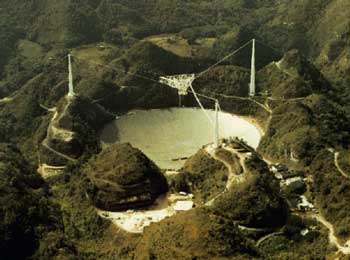|
 AMATEUR
radio hams are usually excited by the faint buzz of a
distant shortwave station, but a group of scientists believe
they have received a message from extra-terrestrials. AMATEUR
radio hams are usually excited by the faint buzz of a
distant shortwave station, but a group of scientists believe
they have received a message from extra-terrestrials.
Astronomers think that a signal picked
up by a radio telescope last year shows the highest probability
yet that ET’s family may have returned his call.
In February 2003, scientists involved
in the search for extra-terrestrial intelligence (SETI)
pointed the huge radio telescope in Arecibo, Puerto Rico,
at about 200 sections of the sky.
Unexplained radio signals had been detected
twice by the same telescope in these areas and scientists
were trying to confirm the findings.
It may sound fanciful, but a report in
the journal NewScientist reveals how the team has now
finished analysing the data, and all the signals seem
to have disappeared - except for one which has got stronger.
Detected on three separate occasions, the signal is "an
enigma", say researchers.
So far, explanations have included conjecture
that it could be generated by a previously unknown astronomical
phenomenon, or may even be something far more pedestrian,
such as an artefact on the telescope itself interfering
with measurements.
But the astronomy team says that it also
happens to be the best candidate yet for a contact by
intelligent aliens in the six-year history of the SETI@home
project, which uses programmes running as screen-savers
on millions of personal computers worldwide to sift through
signals picked up by the Arecibo telescope.
Dr Dan Wertheimer, a radio astronomer
at the University of California (Berkeley) and the chief
scientist for the project, said: "It is the most
interesting signal from SETI@home. We are not jumping
up and down, but we are continuing to observe it."
Named SHGb02+14a, the possible alien communication
has a frequency of about 1420 megahertz - one of the main
frequencies at which hydrogen, the most common element
in the universe, readily absorbs and emits energy.
Some astronomers have suggested that aliens
trying to announce their presence would be likely to transmit
at this frequency, and SETI researchers regularly scan
this part of the radio spectrum.
The unexplained signal appears to be emanating
from a point between the constellations of Pisces and
Aries, where there is no obvious star or planetary system
within 1,000 light years, and the transmission is also
very faint.
Dr Eric Korpela, of the research team,
said: "We are looking for something that screams
out ‘artificial’. This just doesn’t do
that, but it could be because it is distant."
So far, the telescope has managed to pick
up the signal for only about a minute in total, which
is not sufficient for astronomers to analyse it fully.
Dr Korpela believes that it is unlikely
the "message" is the result of any obvious radio
interference or noise, and it does not resemble any known
astronomical object.
Others, however, are more sceptical, saying
the current lack of explanation does not mean that it
could only have been produced by aliens.
Dr Jocelyn Bell Burnell, of the University
of Bath, said: "It may be a natural phenomenon of
a previously undreamed-of kind - like I stumbled over."
It was Dr Bell Burnell who, in 1967, observed
a pulsed radio signal which the research team at the time
believed was from extra-terrestrials, but which later
was confirmed as the first sighting ever of a spinning
collapsed star.
Other questions arise over the signal’s
frequency, which oscillates by between eight and 37 hertz
a second.
Paul Horowitz, a Harvard University astronomer
who looks for alien signals using optical telescopes,
believes that the drift in the signal makes it "fishy".
David Anderson, the director of the SETI@home
project, is also sceptical but curious about the signal.
He told NewScientist: "It is unlikely to be real,
but we will definitely continue to observe it."
Meanwhile, a new analysis of interstellar
communications claims that, rather than sending radio
signals, aliens would find it far more efficient to send
a "message in a bottle".
Scientists at Rutgers University in New
Jersey claim that beaming a radio signal that can be detected
10,000 light years away would demand a million billion
times as much energy as just shooting out matter on which
the data is inscribed.
|